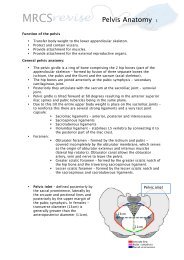You also want an ePaper? Increase the reach of your titles
YUMPU automatically turns print PDFs into web optimized ePapers that Google loves.
<strong>MRCS</strong> <strong>Surgical</strong> <strong>Diathermy</strong><br />
Definition:<br />
<strong>Diathermy</strong> involves the use of high frequency alternating electrical current (A.C.<br />
400kHz-10MHz) to produce a localised heating effect which in turn causes local tissue<br />
destruction. It can be employed to cauterize, cut, desiccate and fulgurate (destroy) tissue.<br />
It is also known as electrosurgery/electrocautery/electrocoagulation.<br />
Note:<br />
1. Greek root - ‘Dia’ - through and ‘thermy’ - heat.<br />
2. Low frequency may stimulate neuromuscular tissue.<br />
Types:<br />
Monopolar<br />
• Current flows from generator to instrument then through patient to a second electrode<br />
(indifferent return electrode) - the diathermy plate.<br />
• Due to surface area of instrument being much smaller than plate there is localised heat<br />
produced at tip of instrument and relatively minimal heat at the plate.<br />
• Surface area of plate over 70cm3.<br />
• Higher power/wattage required.<br />
Bipolar<br />
• Within the instrument two electrodes are combined e.g. forceps.<br />
• When the two forceps tips or electrodes are in contact the circuit is completed -<br />
creating localised heat.<br />
• No patient plate electrode required.<br />
• Lower power/wattage required.<br />
• Safer in patients with pacemakers.<br />
Modes:<br />
The effect of diathermy relies on the current and wave-form.<br />
Cutting<br />
• Continuous current with a sinus wave-form allowing cutting and parallel cauterizing of<br />
the tissue edges.<br />
Coagulation<br />
• Interrupted pulses of current with a square wave-form - mainly for cauterizing and<br />
fulguration.<br />
Blend<br />
• A mixture of both cutting and coagulation modes.
<strong>MRCS</strong> <strong>Surgical</strong> <strong>Diathermy</strong><br />
Complications:<br />
Complication Cause<br />
Burns • Superficial burns from pooling of flammable liquid - spirit based<br />
skin preperations.<br />
• Erroneously placed patient plate electrode.<br />
• Retained heat in electrode.<br />
• Poorly insulated diathermy lead.<br />
• Inadvertent use.<br />
Explosion • Ignition of volatile anaesthetic agents e.g. anaesthetic gases in<br />
bowel.<br />
Electrocution • Poorly insulated diathermy leads.<br />
Pacemaker<br />
interference<br />
• Can reprogram pacemaker.<br />
• Pacemaker wires may conduct current to the heart causing<br />
myocardial burns.<br />
• Prevent - preferentially use bipolar. Only use monopolar in<br />
short, low power waves and ensure plate is positioned so that<br />
current travels away from pacemaker.<br />
Channelling • Avoid use of diathermy on appendages/ narrow pedicles.<br />
Coupling • Current can be induced in other insulated metal conductors -<br />
e.g. metal laparoscopic ports.<br />
Safety:<br />
• Ensure appropriate training.<br />
• Equipment maintenance.<br />
• Avoid incorrect placement of plates - ensuring good contact on dry skin and at least<br />
70cm3 surface area.<br />
• Wipe excess spirit based liquids.<br />
• Sound when diathermy on.<br />
• Place in insulated quiver when not in use.<br />
• Ensure patient is not in contact with earthed materials.




